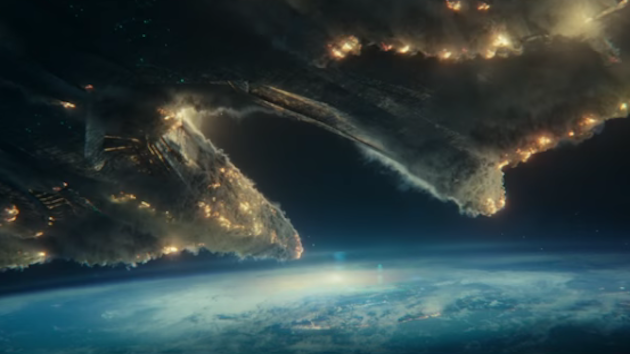
It took 20 years, but the Independence Day franchise returned last Friday to kick some landmark-destroying alien butt and dazzle audiences with a stellar variety of large-scale explosive visual effects. The new film, like the 1996 original, is VFX supervised by Volker Engel and features effects built and blended by some of the best facilities in the business.
1. The sequel has a monster load of effects shots—but not the most ever.
Independence Day featured 430 Oscar-winning visual effects shots, which at the time were some of the most sophisticated on screen. The sequel includes 1,750 effects shots by Uncharted Territory (run by Engel and Marc Weigert), Weta, MPC, Scanline, ImageEngine, Cinesite, Luxx Studios and Digital Domain. For comparison, that's more than 2013's Man of Steel yet just under the 2,100 shots ILM completed, with partner studios Virtuos, Hybride and Base FX, in Star Wars: The Force Awakens. But it's still only a bit more than half the VFX shots in Captain America: Civil War and Avengers: Age of Ultron. While studios may define digital effects shots differently and sheer numbers don't necessarily equal the most complex, no film has yet come close to the 4500+ shots reportedly created for the 2015 epic Bollywood film Baahubali: The Beginning.
Emmerich on set
2. The secret to a more fluid VFX workflow? A barely-there VR camera tracker.
According to FX Guide's deep and exhaustive examination of the film's effects, the virtual production tracker Ncam was used for some 90 percent of the VFX shoot. Ncam uses a lightweight sensor that can be attached to any camera for an unfettered, continuous stream of super-precise positional and rotational data that flows directly into whatever VFX software and graphics engine is being used in post. Camera operators use the Ncam data when framing virtual sets and VFX supes rely on it to build final shots. Director Roland Emmerich thinks "this kind of system is the future" and although he found it took a certain amount of patience to learn to use it effectively on set, it is now his favorite tool.
3. Uncharted Territory did the most shots, but Scanline and Weta among the most complex.
Engel and his team at Uncharted Territory served as the hub for all the effects in the movie and worked closely with Emmerich from start to finish. But Scanline, known for its proprietary Sci-Tech Oscar-winning fluid effects software Flowline that makes quick work of water-based VFX while also making them breathtakingly real, had the gargantuan task of figuring out how to visualize a 3,000-mile-wide alien spacecraft as it descended through earth's atmosphere (at top). Weta pulled out all the stops for the final bus-in-the-dust vs. galloping alien chase sequence.
4. A green beam for the new era.
The iconic green beam that destroyed the White House in the original film is back with a vengeance. We first see it in the opening shots set on the moon. VFX supervisor Sue Rowe and her team at MPC worked alongside Engel to bring geological fidelity to every simulation of the lunar landscape using concept art, NASA images taken through the Hubble Telescope and close study of the moon’s surface. It's one reason the eventual destruction of the organic surfaces look so real. When the alien Mother Ship strikes back, the familiar laser—this time created with RealFlow and Houdini—takes it all down in a flash. MPC also created full CG digital doubles of the actors in their space suits for the final moments of destruction from detailed scans and photographs.
5. This is the fourth film for Roland Emmerich that VFX supe Volker Engel has also produced.
Volker was Co-Producer and VFX Supervisor (with Marc Weigert) for Emmerich's White House Down (2013) and 2012 (2009), and was Executive Producer and VFX Supervisor for the director's 2011 film Anonymous. He co-produced Independence Day: Resurgence. The additional credits were apparently brokered by Emmerich with the studios as a way to give credit where it was long overdue.
Topics: Blog VFX Flowline Houdini ncam realflow Roland Emmerich Scanline Uncharted Territory Volker Engel weta
Did you enjoy this article? Sign up to receive the StudioDaily Fix eletter containing the latest stories, including news, videos, interviews, reviews and more.


